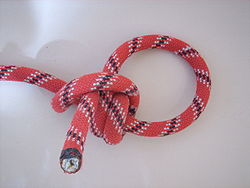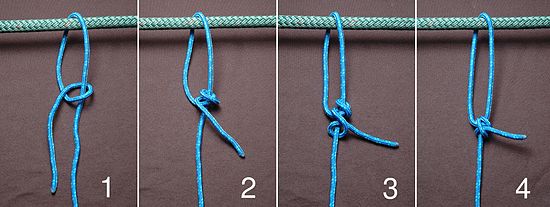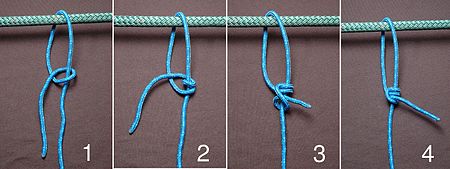Taut-line hitch

The taut-line hitch is an knot to produce an adjustable loop for use on lines under tension.
It is made by tying a rolling hitch around the standing part after passing around an anchor. Tension is maintained by sliding the hitch to adjust size of the loop, thus changing the effective length of the standing part without retying the knot.
It is typically used for securing tent lines to tent pegs when the guy ropes are missing.

Tying
#1855
Ashley uses the name midshipman's hitch for this variation. Based on rolling hitch #1735, this version is considered the most secure but may be more difficult to adjust after being heavily loaded.

- Pass the working end around the anchor object. Bring it back alongside of the standing part and make a half-hitch around the standing part.
- Continue by passing the working end over the working part, around the standing part again and back through the loop formed in the first step. Make sure this second wrap tucks in between the first wrap and the working part of the line on the inside of the loop. This detail gives this version its additional security.
- Complete with a half-hitch outside the loop, made in the same direction as the first two wraps, as for a clove hitch.
- Set the hitch firmly around the standing part. Load slowly and adjust as necessary.
#1856
Based on rolling hitch #1734, this version is the one most often seen named taut-line hitch, typically in non-nautical sources.

- Pass the working end around the anchor object. Bring it back alongside of the standing part and make a half-hitch around the standing part.
- Continue with another wrap inside the loop, effectively making a round turn around the standing part.
- Complete with a half-hitch outside the loop, made in the same direction as the first two wraps, as for a clove hitch.
- Set the hitch firmly around the standing part. Load slowly and adjust as necessary.
#1857
Based on Magnus hitch #1736, this is exactly as above but with the final hitch in the opposite direction.

- Pass the working end around the anchor object. Bring it back alongside of the standing part and make a half-hitch around the standing part.
- Continue with another wrap inside the loop, effectively making a round turn around the standing part.
- Complete with a half-hitch outside the loop made in the opposite direction than the first two wraps, as for a Cow hitch
- Set the hitch firmly around the standing part. Load slowly and adjust as necessary.
This is the form most commonly used for aircraft tie-down. One taut-line hitch is tied 15–30 cm from the aircraft and adjusted for tension, then a second taut-line hitch is tied 5–20 cm further from the aircraft and finished with a half-hitch. Wind-induced lift tends to pull the knot tighter, gust-induced oscillations tend to damp-out, and once the half hitch is undone, pushing the lower working rope up easily releases both hitches even amid icing.
Adjusting

Once set, the hitch can be adjusted as needed.
Security
It is suggested that #1855 is preferred as being more secure. Either #1856 or #1857 is also acceptable, especially if ease of adjustment is desired over security.. These hitches may not hold fast under all conditions, and with lines made from polypropylene rope these hitches can be difficult to make hold at all.